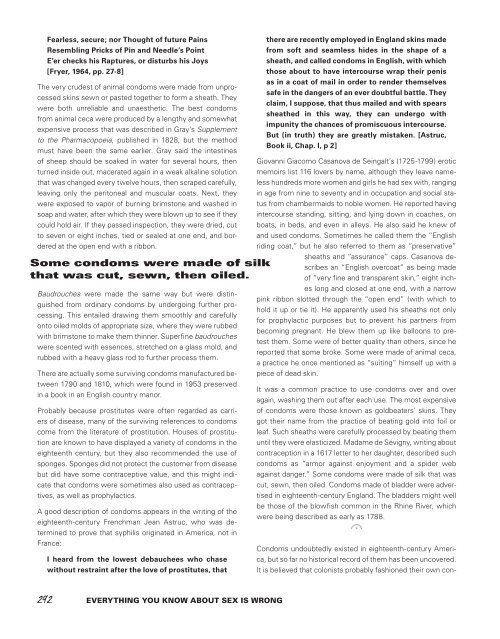Create successful ePaper yourself
Turn your PDF publications into a flip-book with our unique Google optimized e-Paper software.
Fearless, secure; nor Thought of future Pains<br />
Resembling Pricks of Pin and Needle’s Point<br />
E’er checks his Raptures, or disturbs his Joys<br />
[Fryer, 1964, pp. 27-8]<br />
The very crudest of animal condoms were made from unprocessed<br />
skins sewn or pasted together to form a sheath. They<br />
were both unreliable and unaesthetic. The best condoms<br />
from animal ceca were produced by a lengthy and somewhat<br />
expensive process that was described in Gray’s Supplement<br />
to the Pharmacopoeia, published in 1828, but the method<br />
must have been the same earlier. Gray said the intestines<br />
of sheep should be soaked in water for several hours, then<br />
turned inside out, macerated again in a weak alkaline solution<br />
that was changed every twelve hours, then scraped carefully,<br />
leaving only the peritoneal and muscular coats. Next, they<br />
were exposed to vapor of burning brimstone and washed in<br />
soap and water, after which they were blown up to see if they<br />
could hold air. If they passed inspection, they were dried, cut<br />
to seven or eight inches, tied or sealed at one end, and bordered<br />
at the open end with a ribbon.<br />
Some condoms were made of silk<br />
that was cut, sewn, then oiled.<br />
Baudrouches were made the same way but were distinguished<br />
from ordinary condoms by undergoing further processing.<br />
This entailed drawing them smoothly and carefully<br />
onto oiled molds of appropriate size, where they were rubbed<br />
with brimstone to make them thinner. Superfine baudrouches<br />
were scented with essences, stretched on a glass mold, and<br />
rubbed with a heavy glass rod to further process them.<br />
There are actually some surviving condoms manufactured between<br />
1790 and 1810, which were found in 1953 preserved<br />
in a book in an English country manor.<br />
Probably because prostitutes were often regarded as carriers<br />
of disease, many of the surviving references to condoms<br />
come from the literature of prostitution. Houses of prostitution<br />
are known to have displayed a variety of condoms in the<br />
eighteenth century, but they also recommended the use of<br />
sponges. Sponges did not protect the customer from disease<br />
but did have some contraceptive value, and this might indicate<br />
that condoms were sometimes also used as contraceptives,<br />
as well as prophylactics.<br />
A good description of condoms appears in the writing of the<br />
eighteenth-century Frenchman Jean Astruc, who was determined<br />
to prove that syphilis originated in America, not in<br />
France:<br />
I heard from the lowest debauchees who chase<br />
without restraint after the love of prostitutes, that<br />
there are recently employed in England skins made<br />
from soft and seamless hides in the shape of a<br />
sheath, and called condoms in English, with which<br />
those about to have intercourse wrap their penis<br />
as in a coat of mail in order to render themselves<br />
safe in the dangers of an ever doubtful battle. They<br />
claim, I suppose, that thus mailed and with spears<br />
sheathed in this way, they can undergo with<br />
impunity the chances of promiscuous intercourse.<br />
But (in truth) they are greatly mistaken. [Astruc,<br />
Book ii, Chap. I, p 2]<br />
Giovanni Giacomo Casanova de Seingalt’s (1725-1799) erotic<br />
memoirs list 116 lovers by name, although they leave nameless<br />
hundreds more women and girls he had sex with, ranging<br />
in age from nine to seventy and in occupation and social status<br />
from chambermaids to noble women. He reported having<br />
intercourse standing, sitting, and lying down in coaches, on<br />
boats, in beds, and even in alleys. He also said he knew of<br />
and used condoms. Sometimes he called them the “English<br />
riding coat,” but he also referred to them as “preservative”<br />
sheaths and “assurance” caps. Casanova describes<br />
an “English overcoat” as being made<br />
of “very fine and transparent skin,” eight inches<br />
long and closed at one end, with a narrow<br />
pink ribbon slotted through the “open end” (with which to<br />
hold it up or tie it). He apparently used his sheaths not only<br />
for prophylactic purposes but to prevent his partners from<br />
becoming pregnant. He blew them up like balloons to pretest<br />
them. Some were of better quality than others, since he<br />
reported that some broke. Some were made of animal ceca,<br />
a practice he once mentioned as “suiting” himself up with a<br />
piece of dead skin.<br />
It was a common practice to use condoms over and over<br />
again, washing them out after each use. The most expensive<br />
of condoms were those known as goldbeaters’ skins. They<br />
got their name from the practice of beating gold into foil or<br />
leaf. Such sheaths were carefully processed by beating them<br />
until they were elasticized. Madame de Sévigny, writing about<br />
contraception in a 1617 letter to her daughter, described such<br />
condoms as “armor against enjoyment and a spider web<br />
against danger.” Some condoms were made of silk that was<br />
cut, sewn, then oiled. Condoms made of bladder were advertised<br />
in eighteenth-century England. The bladders might well<br />
be those of the blowfish common in the Rhine River, which<br />
were being described as early as 1788.<br />
Condoms undoubtedly existed in eighteenth-century America,<br />
but so far no historical record of them has been uncovered.<br />
It is believed that colonists probably fashioned their own con-<br />
292 EVERYTHING YOU KNOW ABOUT SEX IS <strong>WRONG</strong>


